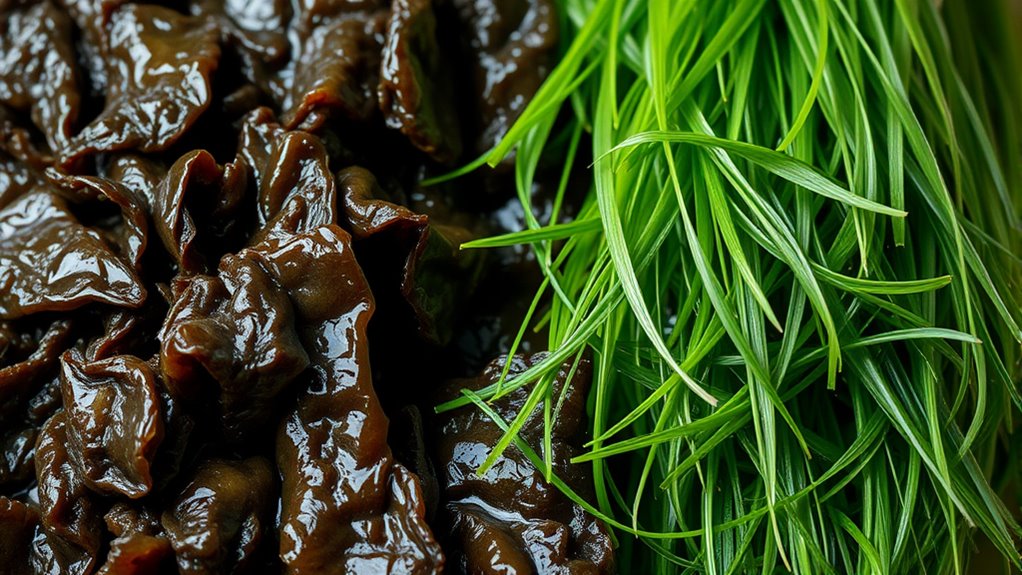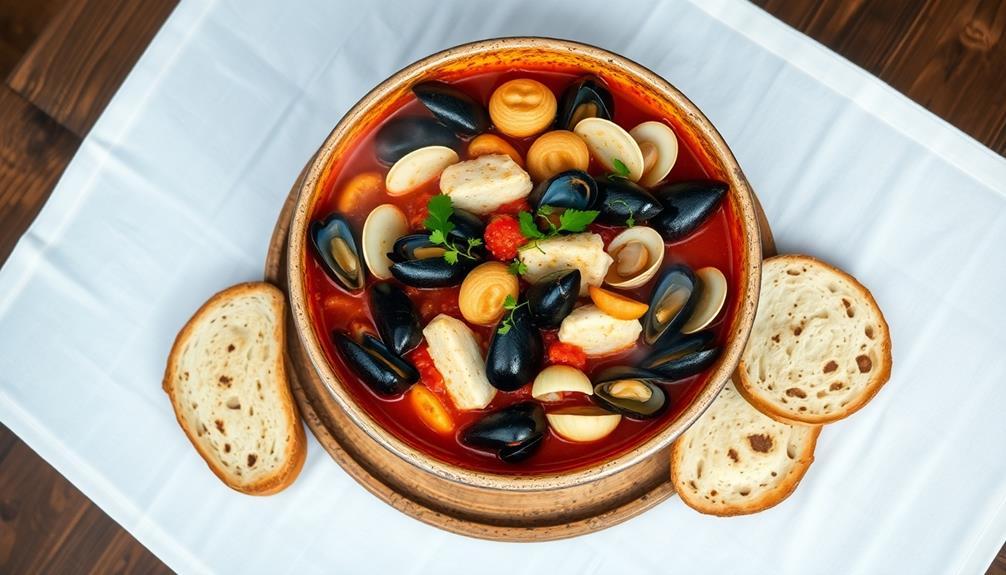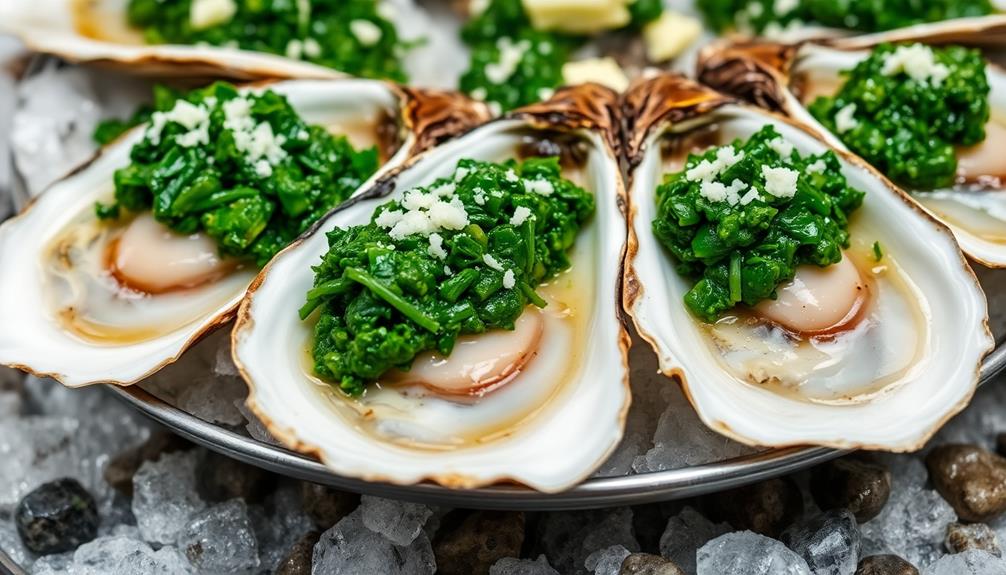Kombu and wakame differ particularly in their mineral content and culinary uses. Kombu packs more iodine, calcium, magnesium, and iron, making it ideal for flavoring broths and long-simmered dishes, and supporting thyroid health. Wakame has a milder, slightly sweet flavor with less iodine but provides essential nutrients for bone, skin, and immune health, great for salads and quick dishes. If you’re curious about their unique benefits and best cooking methods, there’s more to discover here.
Key Takeaways
- Kombu is higher in iodine, calcium, and magnesium, ideal for mineral-rich broths and long cooking, while wakame offers a balanced mineral profile for salads.
- Kombu’s thick, leathery texture makes it suitable for slow simmering and broth bases; wakame’s tender texture is perfect for quick dishes and salads.
- Kombu provides a strong umami flavor, enhancing stocks and broths; wakame has a mild, slightly sweet taste suitable for light, cold dishes.
- Kombu’s sturdy structure allows reuse and gradual flavor extraction during extended cooking; wakame is best added at the end for minimal cooking.
- Both seaweeds support health with their mineral content, but kombu is especially beneficial for iodine intake, while wakame promotes bone and immune health.

When choosing between kombu and wakame, understanding their differences can help you make better culinary and health choices. Both are popular seaweeds used in Asian cuisine, but they offer distinct nutritional benefits and culinary versatility. Recognizing these differences allows you to select the right seaweed for your dishes and health goals.
Choosing between kombu and wakame depends on your culinary needs and health goals.
Kombu is renowned for its impressive mineral content, especially iodine, calcium, magnesium, and iron. Its high iodine levels support healthy thyroid function, which is essential for regulating metabolism. Additionally, kombu contains alginates, natural fibers that can help with digestion and detoxification. These nutritional benefits make kombu a powerhouse of minerals, particularly suited for enriching broths and soups with mineral-rich flavor. Its umami quality makes it a natural flavor enhancer, often used in dashi, the traditional Japanese soup stock. Its thick, leathery texture lends itself well to slow cooking, allowing it to release its nutrients fully into dishes. This long cooking process maximizes nutrient extraction and flavor development. Moreover, kombu’s robust structure allows it to be reused in multiple cooking sessions, reducing waste and enhancing flavor over time. The presence of these unique polysaccharides also contributes to its health benefits, supporting gut health and immune function.
Wakame, on the other hand, offers a different set of nutritional benefits. It’s lower in iodine compared to kombu but still provides a good source of calcium, magnesium, and vitamins A, C, and K. Wakame’s nutrient profile supports bone health, immune function, and skin health. Its softer, tender texture makes it more versatile in fresh salads, side dishes, and light soups. Wakame also boasts a slightly sweet, mild flavor that pairs easily with other ingredients, making it a popular choice for chilled salads and seaweed snacks. Its culinary versatility shines in cold dishes, where its tender texture and subtle flavor complement a variety of ingredients without overpowering them.
In terms of culinary uses, kombu is better suited for creating broth bases and flavoring dishes that require long simmering, thanks to its sturdy structure and flavor-enhancing properties. Wakame is more adaptable for quick preparations, such as salads, miso soup, or garnishes, where its delicate texture can be appreciated without lengthy cooking. While kombu’s robust nature makes it ideal for adding depth to stock, wakame’s lighter profile makes it perfect for adding a nutritious touch to salads and cold dishes. Additionally, choosing the appropriate seaweed can influence your overall nutritional intake, helping you meet specific dietary goals.
Ultimately, understanding these differences helps you tailor your choices to your culinary needs and health priorities. Whether you want the mineral power and umami punch of kombu or the tender, versatile qualities of wakame, understanding their unique benefits ensures you get the most from these nutritious seaweeds.
Frequently Asked Questions
Which Seaweed Has a Higher Iodine Concentration?
You might wonder which seaweed has a higher iodine density, as it’s key for thyroid health. In the seaweed comparison, kombu generally has a substantially higher iodine concentration than wakame. This makes kombu a potent source of iodine, but you should consume it in moderation. Wakame offers a balanced amount, making it suitable for regular use without risking excess iodine intake.
Are There Any Health Risks Associated With Consuming Kombu or Wakame?
You’re right to wonder about health risks; it’s a case of crossing that bridge when you come to it. While kombu and wakame are nutritious, they can pose allergy concerns and heavy metal risks if consumed excessively. Too much iodine from kombu can lead to thyroid issues, and contamination might introduce toxins. Moderation is key, and always check for sources to keep your seaweed intake safe and enjoyable.
Can Kombu and Wakame Be Used Interchangeably in Recipes?
You might wonder if you can swap kombu and wakame in recipes. While they both add flavor, their flavor compatibility differs slightly due to distinct taste profiles. Plus, texture differences matter—kombu is chewy and thick, ideal for broths, whereas wakame is tender and delicate, perfect for salads. So, while you can substitute in some cases, consider these differences to make sure your dish turns out just right.
How Do the Harvesting Methods Differ Between Kombu and Wakame?
Imagine you’re in a time machine, observing how kombu and wakame are harvested today. You’ll see that kombu’s harvesting techniques involve sustainable practices like careful handpicking from deep waters to preserve kelp beds. Wakame, on the other hand, is often farmed on ropes or nets, allowing for more controlled harvesting. Both methods prioritize sustainability, but they differ markedly in approach—kombu’s is more manual and eco-conscious, while wakame’s is more farm-based.
What Are the Environmental Impacts of Harvesting Each Seaweed?
You might wonder about the environmental impacts of harvesting kombu and wakame. Sustainable harvesting practices help minimize ecosystem effects by avoiding overharvesting and protecting marine biodiversity. Kombu, often harvested from deeper waters, can be sustainably collected if managed properly, while wakame’s shallower growth makes it more vulnerable to overharvesting. Responsible methods guarantee these seaweeds support healthy ecosystems without causing long-term damage, allowing continued use and ecological balance.
Conclusion
Thinking about adding seaweeds to your diet? While kombu packs more minerals like iodine and calcium, wakame offers a lighter, milder flavor perfect for salads and soups. Some believe that incorporating both can optimize health benefits, blending the mineral richness of kombu with wakame’s versatility. So, try experimenting with each—your taste buds and body might just thank you—proving that variety truly is the spice of a healthy, flavorful life.









